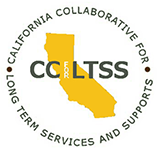The California Collaborative for Long Term Services and Supports is a coalition of statewide organizations which meets regularly to discuss the concerns facing California seniors and people with disabilities. Among the key issues is the growing crisis facing family caregivers. Recently, the Collaborative sponsored a presentation on Picking Up the Pace of Change for California’s Caregivers, a newly released report from the California Task Force on Family Caregiving. The report provides an overview of the compelling challenges facing family caregivers, and outlines public policy for recommendations for California to make improvements to support them.
Emily is typical of a family caregiver facing complex challenges. As a Family Nurse Practitioner and mother of two young children, she is also a caregiver for her aging father Robert, who was diagnosed a year ago with amyotrophic lateral sclerosis, known as ALS. Along with her other responsibilities, Emily travels two hours from Santa Rosa to Sacramento many times each month to accompany her father to medical appointments and oversee his care. Her siblings live out-of-state and her mother, who serves as Robert’s primary caregiver, also works full-time and is overwhelmed with the responsibilities of his care. Emily knows that as her father’s health deteriorates, he will eventually be unable to walk, dress, write, speak, swallow and breathe, and caregiving will become even more emotionally and financially difficult. Due to her medical training, Emily has an advantage over other family caregivers – she has the knowledge and skills she will need to provide care for her father. But despite her training, the responsibilities of her own job, caring for her small children, and being a long-distance caregiver for her father is a difficult balancing act that will become even more challenging as his illness progresses. Continue reading

